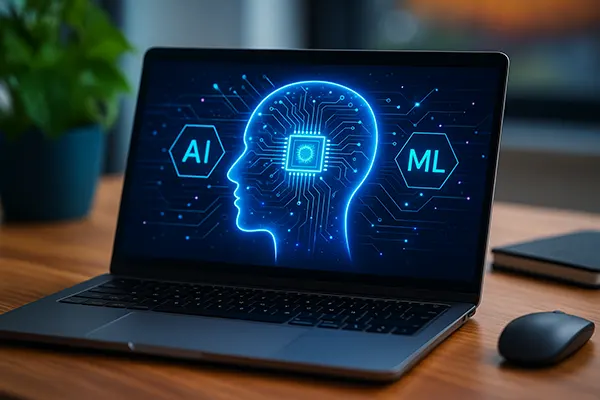
Zero UI on PCs: Are We Ready to Control Computers by Voice and Gestures Without Interfaces?
In 2025, the concept of Zero UI is no longer just a futuristic idea, but a reality that technology companies are actively developing. Zero UI refers to the interaction with computers without traditional graphical interfaces, relying instead on voice, gestures, and other natural inputs. With the rapid growth of artificial intelligence, natural language processing, and motion sensors, the way we communicate with PCs is undergoing a radical transformation.
The rise of Zero UI in personal computing
In recent years, advances in AI-driven voice assistants, such as Microsoft’s Copilot and Apple’s Siri updates, have made it possible for users to perform complex tasks with simple voice commands. From searching files to launching applications, many processes are now fully manageable through natural speech. At the same time, gesture recognition technologies, developed by companies like Intel and Leap Motion, are being integrated into consumer devices, turning the air around us into an input surface.
These innovations are driven by the demand for more intuitive computing experiences. As devices become smaller, lighter, and in some cases screenless, the reliance on traditional keyboards and mice becomes less practical. Zero UI promises seamless interaction, where users can multitask more efficiently without being constrained by hardware.
Yet, despite this promise, the transition is not straightforward. Adopting Zero UI requires not only robust software but also hardware that can interpret subtle human signals with high accuracy. This creates both opportunities and challenges for developers and manufacturers in 2025.
Challenges of mainstream adoption
While voice recognition has reached impressive accuracy levels—often exceeding 95%—it still struggles with accents, background noise, and contextual understanding. For gesture control, the issue is even more complex: sensors must differentiate between intentional gestures and natural, unconscious body movements, which often results in misinterpretations.
Another critical challenge is user privacy. Always-on microphones and cameras required for Zero UI raise concerns about constant monitoring. Tech companies must ensure transparent data usage policies and secure local processing of sensitive information to gain user trust.
Furthermore, accessibility is a double-edged sword. Zero UI can empower individuals with physical disabilities by providing hands-free control. However, for users with speech impairments or limited mobility, voice and gesture interfaces may not always provide inclusive solutions. Balancing inclusivity remains one of the biggest hurdles.
How Zero UI transforms user experience
By removing layers of traditional interaction, Zero UI aims to make computing feel more natural. Instead of navigating through menus, users can simply say, “Send the latest report to my team,” or swipe their hand to change slides during a presentation. This minimises cognitive load and speeds up workflows.
Beyond productivity, entertainment and gaming sectors are also embracing Zero UI. In 2025, gesture-controlled VR and AR headsets are mainstream, offering immersive experiences without controllers. Voice commands allow players to issue real-time strategies, making gameplay more dynamic and intuitive.
In workplaces, Zero UI reduces friction in collaboration. During meetings, voice-driven note-taking tools and gesture-based presentation controls enable smoother communication. These small improvements accumulate into significant efficiency gains, reshaping how people interact with PCs in professional settings.
Integration with AI and IoT
Zero UI does not exist in isolation; it works hand in hand with AI and the Internet of Things (IoT). PCs connected to smart environments can execute commands that extend beyond the computer itself. A voice instruction to “dim the lights and open my presentation” synchronises multiple devices simultaneously.
With generative AI systems, the interaction becomes even more intelligent. Instead of merely following commands, PCs can anticipate user needs, suggesting actions based on context. For example, if a user begins drafting an email, the AI might proactively provide relevant attachments or suggest recipients.
This deeper integration enhances convenience but raises important ethical questions. How much autonomy should AI-driven Zero UI have? Striking the right balance between proactive assistance and user control is essential for building trustworthy systems.

The future of Zero UI on PCs
Looking ahead, the widespread adoption of Zero UI will depend on both technological advancements and societal acceptance. Hardware manufacturers are already investing in sensors that capture micro-expressions and subtle gestures, while software developers refine algorithms to ensure contextual understanding. If successful, this could redefine how humans interact with technology altogether.
Education and professional training will also adapt. Instead of teaching students shortcuts and menus, curriculums may focus on optimising natural communication with machines. This shift could make technology more approachable for future generations, reducing the learning curve associated with traditional PCs.
However, Zero UI will not fully replace conventional interfaces. Instead, it is likely to coexist with keyboards, mice, and touchscreens, offering users multiple input options depending on context. This hybrid model ensures flexibility while maintaining familiarity, easing the transition into a post-interface era.
Are we truly ready?
Whether society is fully prepared for Zero UI depends on more than just technology. It requires trust in how companies manage data, the development of ethical standards for AI, and a cultural willingness to embrace new forms of interaction. Some users may welcome hands-free computing, while others may remain hesitant due to concerns over control and privacy.
In 2025, pilot projects in education, healthcare, and corporate environments are demonstrating the real potential of Zero UI. Hospitals are testing gesture-based systems for surgeons, while businesses are adopting voice-driven productivity tools. These early adopters pave the way for broader societal readiness.
Ultimately, the readiness question is less about capability and more about choice. Zero UI is no longer a distant vision; it is here. The coming years will show how seamlessly it integrates into everyday life and whether society embraces or resists this evolution in computing.



